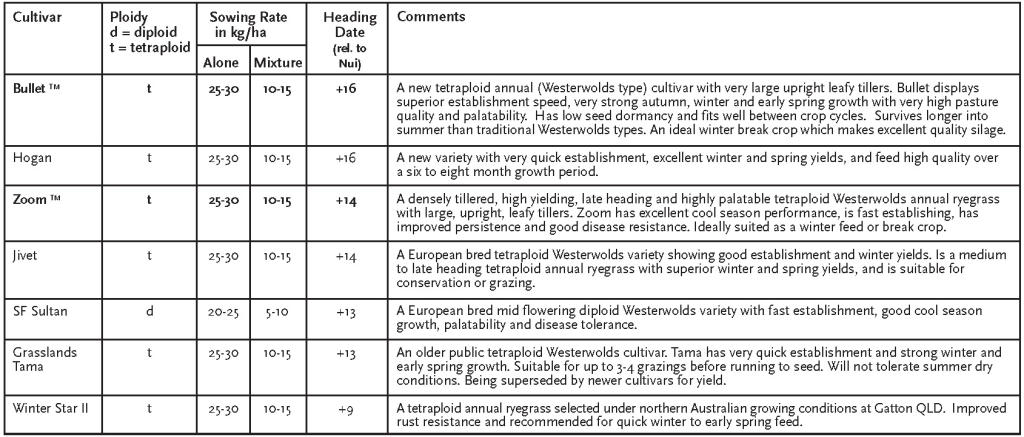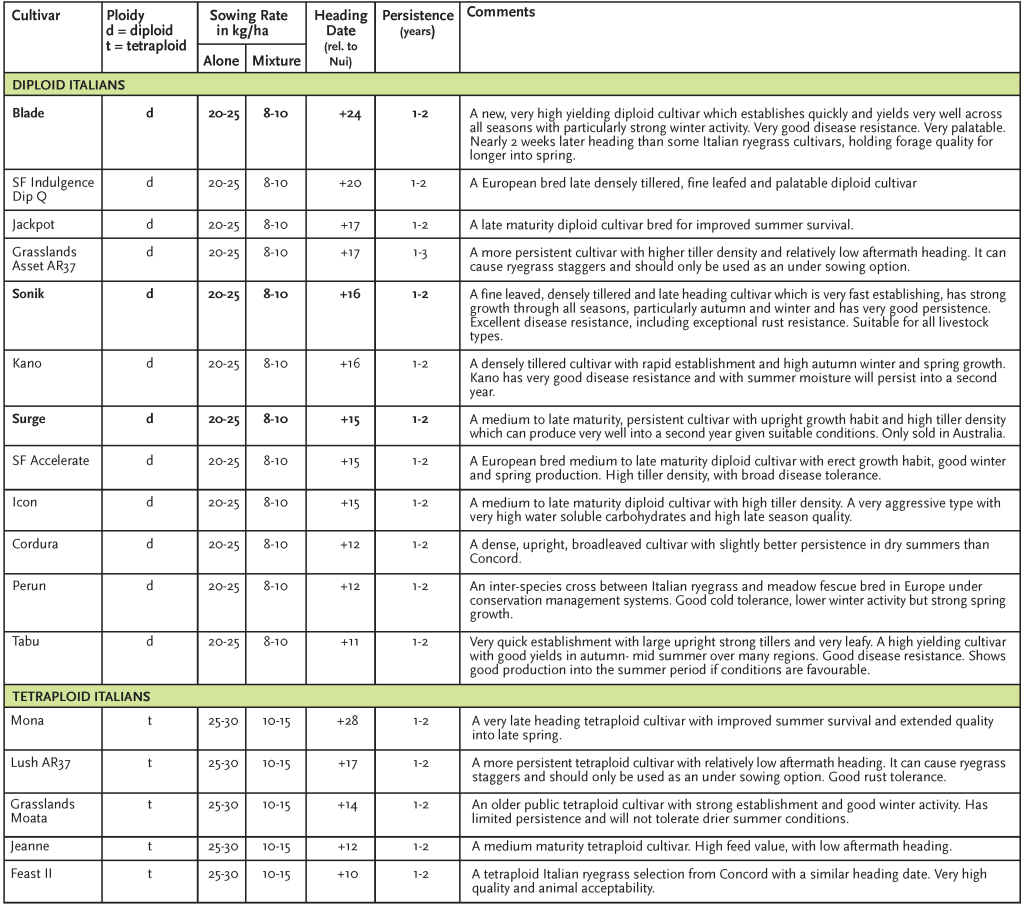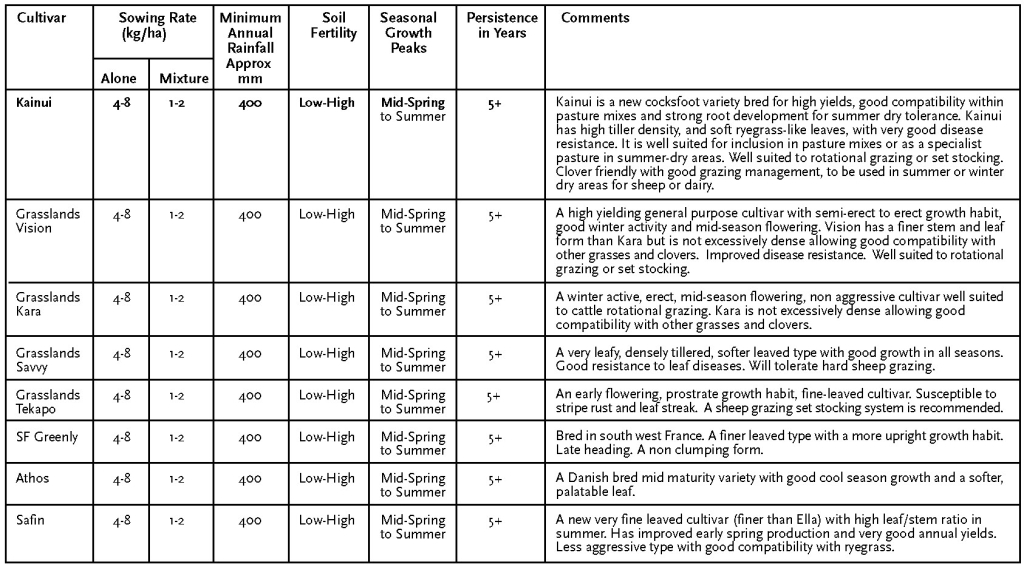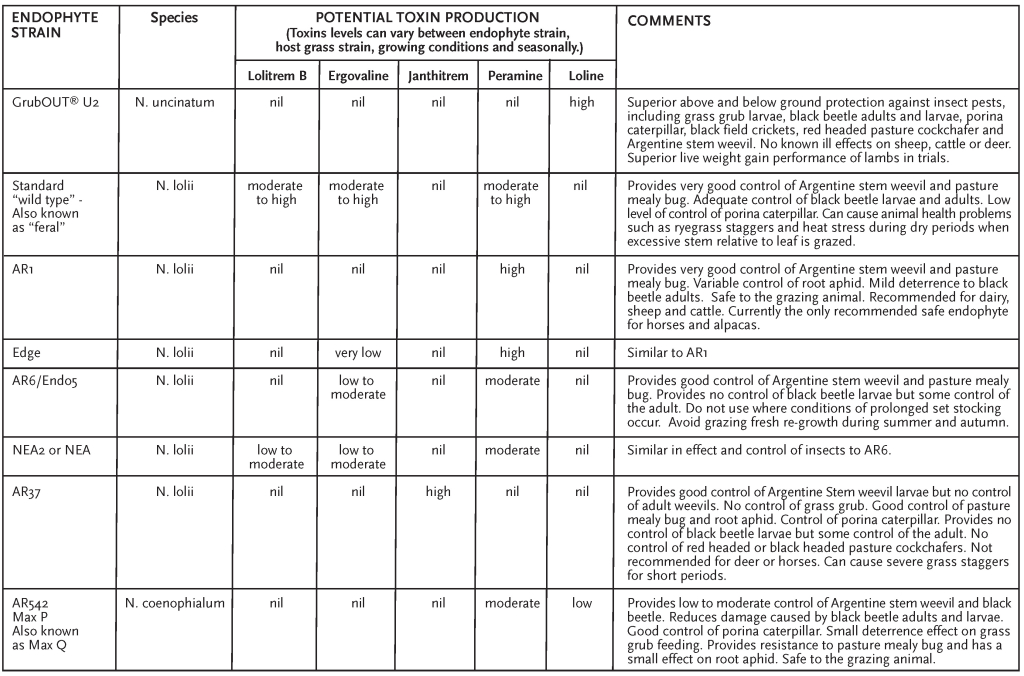Our Forage Wall Chart is designed to give you a overview of forage cultivars available on the market, detailing their growth, persistence, sowing rates & endophyte status. It also features helpful comments on each cultivar.
Click on the tabs or download our Forage Wall Chart below.
[tabs class=”Forage Wall Chart”]
[tab title=”Perennial Ryegrass” active=”active”]
PERENNIAL RYEGRASS
A perennial species with good acceptability to grazing stock and well suited to New Zealand grazing systems. The newer tetraploid perennial cultivars are generally more palatable to livestock but generally produce less dry matter than diploid cultivars.
Ploidy & Heading Date: Tetraploids have larger seed size requiring higher sowing rates. They also require more careful grazing management to prevent overgrazing, and may also require higher fertility and adequate moisture to perform well. Newer later heading cultivars tend to produce higher late spring quality, and often have greater winter activity than some of the older early heading cultivars. They often have higher tiller densities and sowing rates should be reduced 2-3kg/ha from what is considered normal for tetraploids.
Click here for more information on the PERENNIAL RYEGRASS’ available from Notman Pasture Seeds

[tab title=”Annual Ryegrass”]
ANNUAL RYEGRASS
Westerwolths (or Westerwold) annual ryegrass is used as a temporary cool season feed between crops and will produce seed from a spring sowing, generally persisting for only 6-8 months. Should be autumn sown.
Click here for more information on the ANNUAL RYEGRASS’ available from Notman Pasture Seeds

[tab title=”Italian Ryegrass”]
ITALIAN RYEGRASS
Italian ryegrass is usually erect, large leaved, producing very high yields of high quality forage and requiring a winter period to form seed. If present, the annual ryegrass endophyte strain will confer seedling resistance to Argentine stem weevil, allowing earlier autumn sowings. This strain is not associated with animal health problems.
Tetraploid types are larger plants which perform best under high fertility moist conditions. Grazing animals tend to prefer tetraploid plants which can lead to higher feed intake and performance.
Click here for more information on the ITALIAN RYEGRASS’ available from Notman Pasture Seeds

[tab title=”Cocksfoot”]
COCKSFOOT
A slower establishing, productive, drought tolerant perennial grass species which grows strongly in summer. Cocksfoot is best used in drier, moderate fertility and free draining soils. Cocksfoot once established resists pasture pest attack. Its forage quality is not as good as perennial ryegrass and the species requires grazing to prevent excessive seed head development during spring.
Best sown when soil temperatures are warm. Upright forms of Cocksfoot may be mixed with perennial ryegrass and phalaris. Lower seeding rates of the prostrate forms should be considered if used in mixes.
Click here for more information on COCKSFOOT available from Notman Pasture Seeds
[tab title=”Tall Fescue”]
TALL FESCUE
A slower establishing, deep rooted, drought tolerant perennial grass species which best suits high fertility and heavy or wetter soils. Tall fescue grows throughout New Zealand but its advantages over ryegrass are greatest in environments with warm-hot summers, soils that often dry out and where insect damage is a problem for ryegrass. The optimum temperature for perennial ryegrass growth is 20°C with production declining above 24°C. The optimum for tall fescue is 26°C, with growth continuing into the mid 30°C.
Best used in areas which receive periodic summer moisture. Tall fescue tolerates acid, alkaline soils and poor drainage. Tall fescue responds well to nitrogen. The seed is best sown in warm soils above 12 °C and should not be mixed with ryegrass as it will not ultimately compete and the fescue soon disappears. Can be mixed with less competitive species such as upright cocksfoot cultivars, timothy, phalaris, Yorkshire fog, and brome species.
Selected strains of tall fescue endophyte such as Max P offer significant benefits in terms of insect toxicity compared to nil endophyte, but compared to wild endophyte strains have reduced toxicity to livestock. Graze frequently during spring to prevent seed head build up and to thereby maintain quality. Tall Fescue cultivars can be classified according to growth pattern as “Mediterranean”, “Oceanic”, or “Continental”. Mediterranean types are generally summer dormant and winter active, Oceanic types grow year round, while Continental types are summer active and winter dormant.
Click here for more information on TALL FESCUE available from Notman Pasture Seeds
[/tab]
[tab title=”Endophytes”]
ENDOPHYTE
Grass plants may contain an internally growing fungus called endophyte. Different strains of endophyte are available in many of the grass cultivars
The Standard strain implies that the cultivar contains a wild type endophyte which will help resist insect attack (eg Argentine stem weevil, Black beetle), and help to prevent over-grazing but may, particularly in dry summer conditions, cause ryegrass staggers and reduce animal growth rates.
Low endophyte implies low or nil endophyte infection levels in the seed and its use is best suited to areas of low insect predation generally associated with high summer moisture. Novel strains are now being developed which may or may not cause ryegrass staggers but generally have some level of toxicity to some of the pasture insect species.
Insect response to these strains is variable, dependent on the strain of novel endophyte and the reaction of the grass cultivar to it. Endophyte levels in seed generally decline in seed lines stored for more than a year under normal ambient conditions. Endophyte viability can be improved by storing seed under conditions of low humidity and temperature. Seed lines can be tested for current and viable endophyte level.
Click here for more information on ENDOPHYTES available from Notman Pasture Seeds
[/tab][/tabs]










